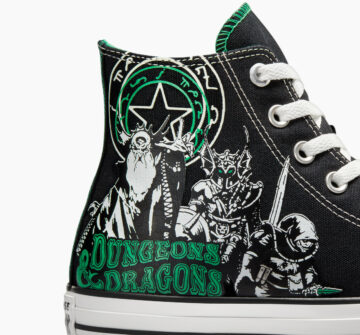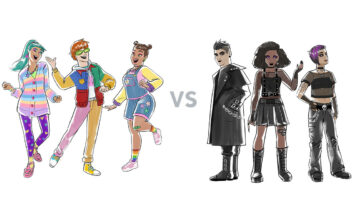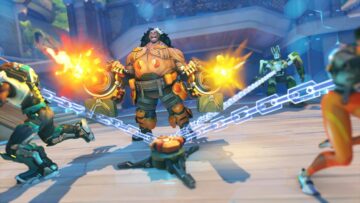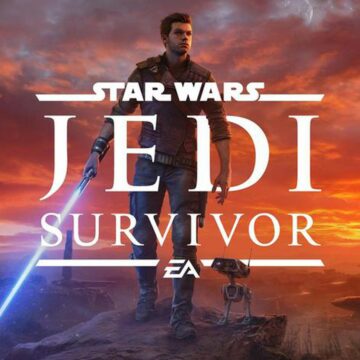Netflix’s animated movie Nimona is a deconstructive fairy tale that tackles rebellion and rebirth. Born from ND Stevenson’s Tumblr-published webcomic, the movie, centering on a rebellious, anarchistic pink-coded shapeshifter, evolved significantly from the page to the CGI incarnation.
Nimona herself has come back from the dead over and over. One of her many consequential rebirths was a matter of studio intervention: When Disney bought out 20th Century Animation, the company canceled the animated adaptation of Stevenson’s book, which was 75% completed at 20th Century’s subsidiary Blue Sky Studios. (Blue Sky employees are adamant that Disney shut down the project because two of Nimona’s characters are gay.) But Annapurna Pictures and Netflix breathed life back into the project.
Resurrection is a key part of Nimona — and so is changing form. Both of these things come into play in the movie’s radical departures from the book. This latest rebirth gives Nimona a new shape, with plenty of fire to spare — but while purists may object to all the changes from the original book, they were an absolute necessity.
[Ed. note: Major spoilers ahead for the graphic novel Nimona, and implied spoilers for the movie version.]
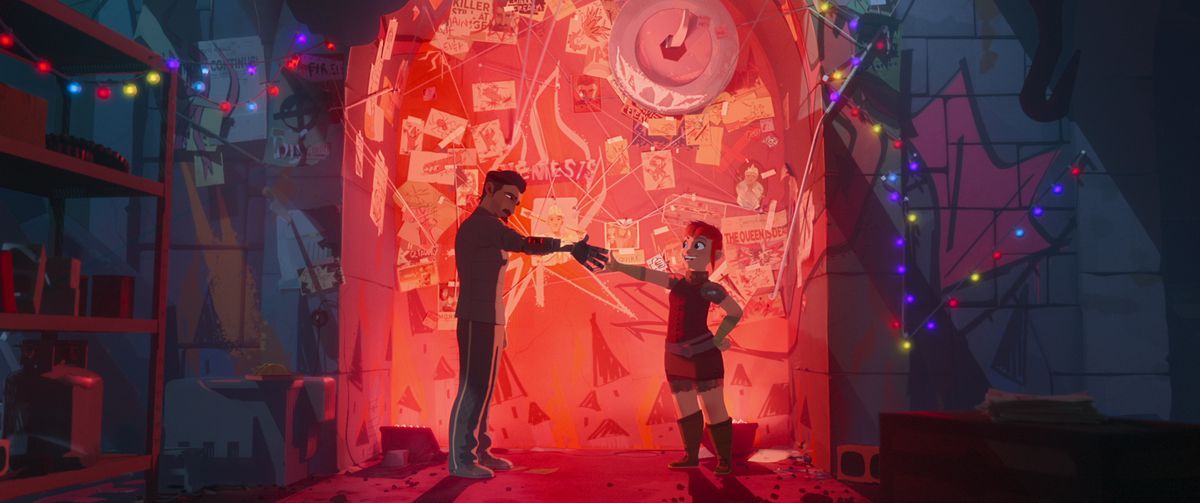
Death, rebirth, and radical change in Nimona
In the graphic novel that collects Stevenson’s webcomic, Nimona appears to die, but revives, which leads to a reveal that she has a Wolverine-level ability to heal herself. Then she supposedly perishes for good at the climax of the story, but with a strong suggestion that she escapes. The movie version grants her another revival, one as tantalizing as her first ending, yet with an intriguing new light.
The Nimona movie adaptation shape-shifts away from Stevenson’s original art style. The film version, directed by Nick Bruno and Troy Quane, gives its character softer curves and bigger, more sensitive eyes, using 3D cel-shading stylization to add a gloss to Stevenson’s work. Screenwriters Robert L. Baird and Lloyd Taylor also map a different quest for Nimona and company.
The book’s star-crossed knights, Ambrosius Goldenloin (Eugene Lee Yang) and Ballister Blackheart (renamed Boldheart, and voiced by Riz Ahmed) have evolved into explicitly cute and tragic boyfriends who hold hands, snuggle, and make out. The bitter, competent, morally gray version of Ballister is now a sensitive, hapless man, openly wronged and heroically flawed. Our pink Nimona is as chaotic as ever, though, just with pointier teeth and mischievous flames dancing in her pupils, and with Chloë Grace Moretz going punkishly hard on her gremlin attitude.
Enter Ballister, a commoner-born fugitive knight framed for the assassination of his kingdom’s queen. He seems like the perfect bestie for Nimona, who’s carrying a grudge against the kingdom, a futuristic-medieval world packed with archaic hierarchical practices, including hero-worship of its own Almighty, the late, legendary Gloreth (Karen Ryan).
What changed from the Nimona comic to the movie?
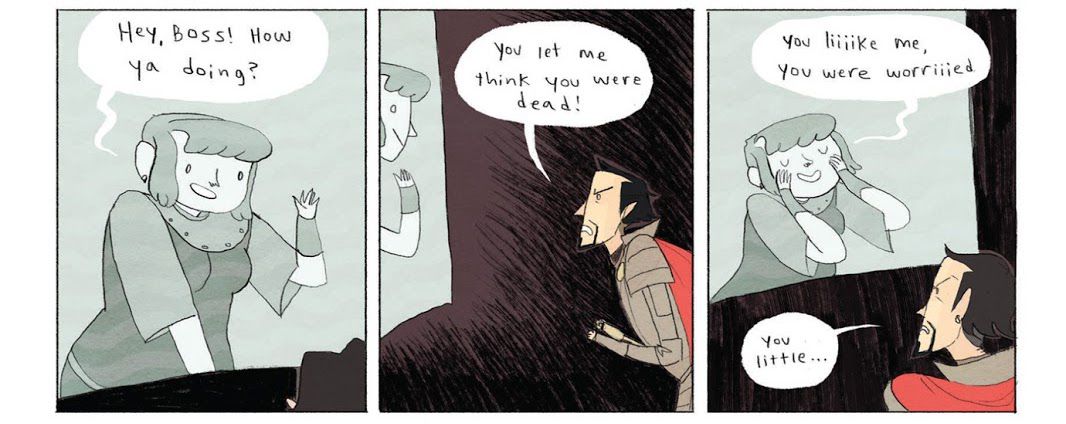
Whereas Ballister and Nimona in the book have a Magneto-and-Mystique supervillain synchronization (even though they butt heads on taking lives), the movie versions of the characters start out with more mismatched motives. For starters, Ballister wants to clear his name and win back the good graces of the kingdom (and his hot boyfriend Ambrosius), while Nimona is hungry to lash out against the Institution, the organizing power that stamped them both as outsiders.
Over the years, hindsight and evolution have found the queer story seeds in Nimona — seeds even Stevenson didn’t recognize when he was writing it, but that he now sees as key to a story that already had “transness and gender fluidity at its heart.” The eponymous shape-shifter has been the subject of a number of queer-lensed theses, including Molly Clare Barnewitz’s “The animal as queer act in comics: queer iterations in On Loving Women and Nimona,” and Heather Wright’s “The Childish, the Transformative, and the Queer.”
Stevenson himself has reflected on the ways Nimona was an outlet for expressing his own nonconforming gender identity. He’s expressed kinship with fictional shape-shifters, including Zam Wesell from Attack of the Clones and the shape-shifting Double Trouble in Stevenson’s animated Netflix series She-Ra and the Princesses of Power, voiced by nonbinary actor Jacob Tobia.
“The desire to shape-shift […] has so much meaning in my life now,” he has said. Since the publication of Nimona, Stevenson has come out as nonbinary and transmasculine. It’s hard to divorce Nimona’s transformational fluidity from Stevenson’s personal transition comic, The Weight of Them: “I wanted to be a magic eye picture,” he says in that comic. “A shapeshifter.”
Nimona is a queer metaphor, in both versions
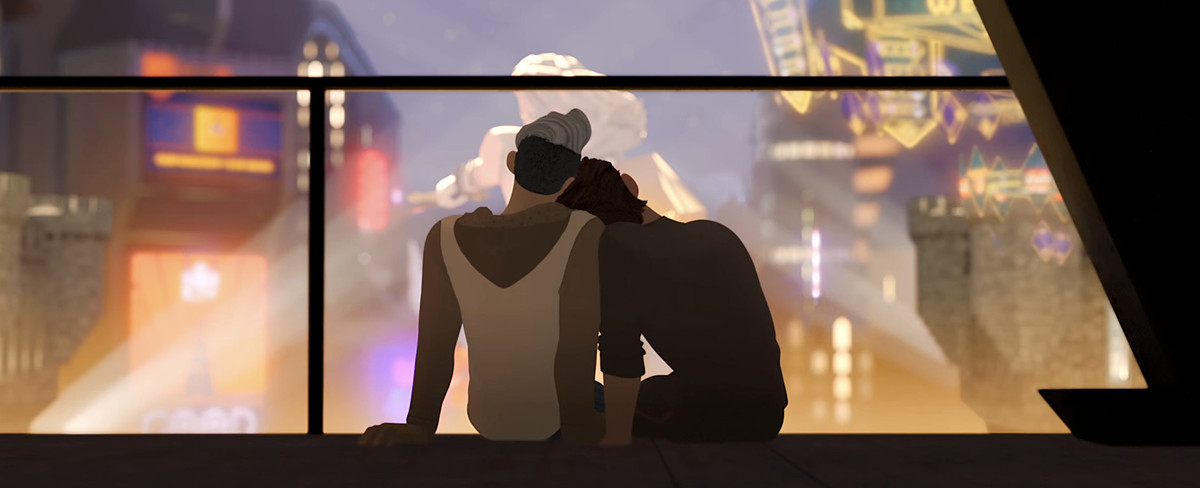
Using dialogue that wasn’t in the source material, the movie leans into Nimona’s shape-shifting as one of those flexible metaphors, heavily shading it into a stand-in for gender fluidity. Although Nimona unabashedly weaponizes her transformations, the movie makes it clear that they aren’t just pranks or battle assets. Changing form is a euphoric experience for her, whether she’s munching on pizza as a gorilla or shaking Ballister’s hand as a shark. (Cue her iconic line, “I’m a shark!”) Those expressions of her flexibility of form unnerve Ballister, who was kingdom-bred to be suspicious of anything inhuman.
Nimona is constantly pining for validation from Ballister, the guardian, parent, friend, or sibling she never had. But he prefers her humanoid shape and assumes it represents the only real version of her, demanding, “Can you just be you?” It’s essentially an equivalent of the X-Men series’ famous metaphor for uncomfortable parents trying to shut down their kids’ queerness: “Have you tried not being a mutant?”
Nimona’s answer is telling. “I feel worse when I don’t do it.” She tells Ballister that if she bottles up her shape-shifting, she’ll “die.” When he reacts with horror, she clarifies, “I wouldn’t die-die. I just sure wouldn’t be living.” It’s meant as a distillation of the way a queer kid feels about being cornered in the closet, and forced to present themselves against their identity.
Why Nimona’s ending had to change
![In a six-panel spread from the original Nimona comic, young red-haired shapeshifter Nimona argues with armored knight Ballister. Dialogue: “You’re an inspiration!” “Yes, well, I don’t need a sidekick.” “Oh come on! EVERYONE has a sidekick these days.” “I can’t have some KID following me around all day.” “I’m not a kid.” [She abruptly turns into a shark.] “I’M A SHARK!” Ballister: “Aaaahh!” In the final panel, she just grins sharkily at him.](https://platoaistream.net/wp-content/uploads/2023/07/nimonas-radical-page-to-screen-story-changes-were-a-queer-necessity-3.jpg)
With those clarified elements in mind, changed by time, context, and Stevenson’s own personal revelations, it was absolutely necessary for the movie version of Nimona to overhaul its third-act confrontation. In the comic, the nefarious Director imprisons Nimona, who splits her soul open to escape. The angriest and most frustrated parts of her manifest into a dark dragon that assumes a life of its own. Ballister and the other half of Nimona — presenting as a small, vulnerable child — attempt to re-bond her with her dragon form in hopes of dissipating the danger.
But the two halves of her can no longer merge. The split culminates in an emotional confrontation where Ballister attempts to talk Nimona’s dragon form down, to no avail. So he has to do the impossible. Not without remorse, he shoots Nimona’s blackened monster form with a powerful poison stolen from the Director.
Ballister and Nimona do subsequently reconcile, in an indirect, fleeting way. With a distant wave in the crowd, she both reveals that she’s survived Ballister’s attack, and has decided to go her own separate way. This bittersweet outcome largely suggests that she either wants to find her own healing, or that she deems herself unsavable — and that she no longer wants Ballister’s help either way.
The film’s rendition takes a different path, without any soul-splitting. Instead, there’s a soul corruption, activated by Nimona’s trauma. When Nimona’s emotional breakdown transforms her into a kind of seething, black kaiju, she considers suicide, moving to destroy herself on the sword of a statue of Gloreth, as if to concede to the kingdom’s monster-hating propaganda. The movie ramps up the stakes, avoiding clarifying or developing Nimona’s self-healing powers, and demonstrating that self-annihilation is possible for her.
In this version, Ballister doesn’t resort to an “ends justify the means” attack. The film’s antagonist, the Director (Frances Conroy) who framed Ballister, moves to destroy Nimona, even though it would mean killing countless civilians as well. Accepting responsibility for his previous outburst against Nimona, Ballister has to toss aside his sword to save her, pushing her away from self-impalement and delivering this affirmation: “I see you, Nimona. You’re not alone.”
The original comic ending, where Nimona’s guardian figure kills off her darkest form, would have felt like an unintentional subversion of its queer-positive metaphor. Ballister’s approach in the source material would read remarkably differently in this historical moment, especially when the civil rights of gender-nonconforming and transgender children are increasingly at stake. Likewise, if Ballister brandished a weapon against Nimona, it would play against the movie’s anti-military theme and his own arc to deprogram himself of his knighthood teachings.
Instead of fighting her darkest side — and assuming it’s something that can be separated from her — he embraces it. Ballister saving Nimona from despair and suicide feels like an assurance for queer viewers that they deserve to be saved and loved, not split in two. Their grief at facing bigotry or isolation doesn’t deserve punishment, but compassion, even in their messiest moments.
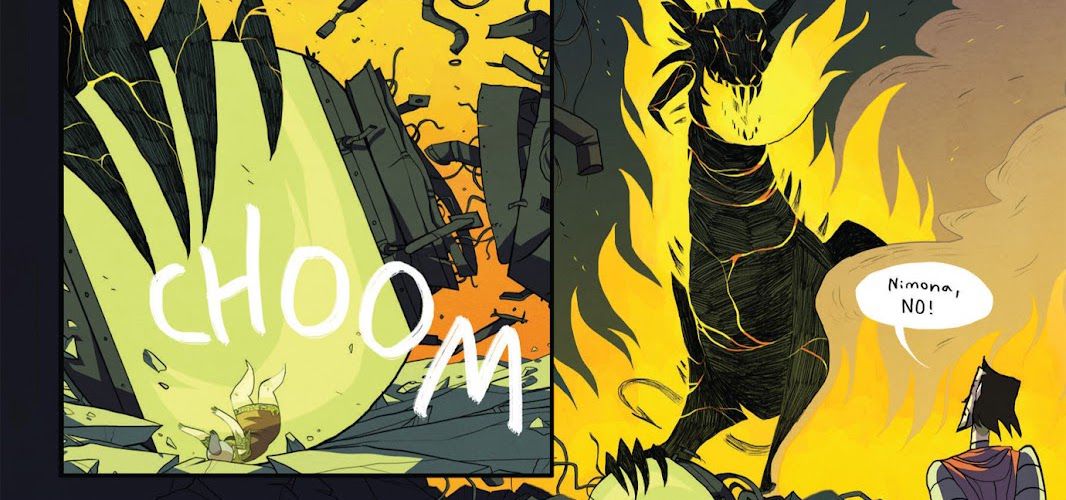
Emboldened, Nimona redirects her energy away from self-annihilation and channels her strength to save the kingdom’s civilians against the Director’s weapon, a sacrifice that recalls the Iron Giant flying into a missile. Her transformation — her final shape-shift on screen — into a blazing phoenix-like titan hints toward her eventual resurrection, as she seeks a world that’s kinder to her.
The updated version of Nimona amplifies its vocal statement about prejudice against the othered. The kingdom’s battle cry, “Go back into the shadows from whence you came!” passed down from Gloreth, is branded as heroic dogma. But it acquires a crueler connotation once a flashback unravels Nimona and Gloreth’s doomed childhood friendship, severed by social panic that corrupts the innocent Gloreth into betraying her friend.
The kingdom’s history was written to erase and target Nimona’s non-normative humanity, as well as her access to companionship, community, and light. In this Nimona retelling, it says a lot that her implied resurrection and face-to-face reunion with Ballister signals that she’s more open to company. Light has never been safer for her.
Nimona is streaming on Netflix now.
- SEO Powered Content & PR Distribution. Get Amplified Today.
- PlatoData.Network Vertical Generative Ai. Empower Yourself. Access Here.
- PlatoAiStream. Web3 Intelligence. Knowledge Amplified. Access Here.
- PlatoESG. Automotive / EVs, Carbon, CleanTech, Energy, Environment, Solar, Waste Management. Access Here.
- BlockOffsets. Modernizing Environmental Offset Ownership. Access Here.
- Source: https://www.polygon.com/23779997/nimona-book-comic-vs-movie-changes-queer-reading
- :has
- :is
- :not
- :where
- $UP
- 3d
- 50
- a
- ability
- About
- above
- abruptly
- Absolute
- absolutely
- accepting
- access
- Acquires
- Act
- activated
- adaptation
- add
- against
- ahead
- All
- alone
- already
- also
- Although
- Amazon
- an
- and
- animal
- animation
- Another
- answer
- any
- anything
- approach
- Arc
- archaic
- ARE
- Arena
- Argues
- around
- Art
- AS
- Assets
- assumes
- assurance
- At
- attack
- Attempts
- avoiding
- away
- back
- Battle
- BE
- because
- been
- being
- bigger
- Black
- BLAZING
- Blue
- Blue Sky
- book
- born
- both
- bought
- branded
- Breakdown
- Bright
- Bruno
- but
- by
- CAN
- canceled
- carrying
- CATWALK
- CBR
- centering
- Century
- CGI
- change
- changed
- Changes
- changing
- channels
- character
- characters
- child
- Civil Rights
- civilians
- clarified
- class
- clear
- collects
- COM
- come
- community
- company
- competent
- consequential
- considers
- Conspiracy
- constantly
- Container
- context
- cornered
- Corruption
- crowd
- Dancing
- DANGER
- Dark
- day
- Days
- dead
- decided
- delivering
- demanding
- demonstrating
- departures
- deserve
- desire
- destroy
- developing
- dialogue
- Die
- different
- directed
- Director
- Disney
- Distant
- do
- Doesn’t
- doing
- Dont
- Doomed
- double
- down
- Dragon
- effect
- either
- elements
- Embraces
- emotional
- employees
- energy
- Equivalent
- escape
- especially
- essentially
- Ether (ETH)
- eugene
- Even
- eventual
- everyone
- evolution
- evolved
- experience
- expressing
- expressions
- eye
- Eyes
- facing
- famous
- feel
- fictional
- fighting
- Figure
- Film
- final
- Find
- Fire
- First
- flawed
- Flexibility
- flexible
- fluidity
- flying
- following
- For
- forced
- form
- found
- friend
- Friendship
- from
- front
- frustrated
- Gender
- Girl
- gives
- Go
- going
- good
- grants
- gray
- Green
- guardian
- had
- Half
- hand
- Hands
- Hard
- Have
- he
- head
- heads
- healing
- Heart
- heavily
- help
- her
- High
- him
- hindsight
- hints
- his
- historical
- history
- hold
- holding
- hopes
- horror
- HOT
- How
- HTML
- HTTPS
- huge
- Humanity
- Humanoid
- Hungry
- i
- iconic
- Identity
- if
- implied
- impossible
- in
- Including
- increasingly
- innocent
- instead
- Institution
- intervention
- into
- intriguing
- isolation
- IT
- iterations
- ITS
- jpg
- just
- karen
- Key
- Kid
- Kills
- Kind
- Kingdom
- Knight
- largely
- Late
- latest
- Leads
- Lee
- legendary
- let
- Life
- light
- like
- likewise
- Line
- Lives
- longer
- LOOKS
- Lot
- loved
- magic
- make
- MAKES
- man
- many
- map
- material
- Matter
- May..
- me
- mean
- meaning
- meant
- Men
- Merge
- mind
- moment
- Moments
- more
- most
- moves
- movie
- Movies
- moving
- much
- my
- name
- necessary
- Need
- Netflix
- never
- New
- nick
- no
- note
- novel
- now
- number
- object
- of
- off
- on
- once
- ONE
- only
- open
- openly
- or
- organizing
- original
- Other
- our
- out
- Outcome
- outlet
- over
- Overhaul
- own
- packed
- page
- pair
- panel
- panels
- Panic
- parents
- part
- parts
- passed
- path
- perfect
- personal
- picture
- Pictures
- Pizza
- plato
- Plato Data Intelligence
- PlatoData
- Play
- Plenty
- poison
- Polygon
- possible
- power
- powerful
- powers
- practices
- present
- previous
- project
- Propaganda
- Publication
- Pushing
- quest
- radical
- Ramps
- reach
- Reacts
- Read
- real
- reflected
- represents
- Resort
- responsibility
- reveal
- Reveals
- rights
- ROBERT
- Ryan
- sacrifice
- safer
- Said
- Save
- saving
- says
- Screen
- see
- seeds
- Seeks
- seems
- sees
- sensitive
- separate
- Series
- Shape
- Shark
- she
- Shut down
- side
- Sidekick
- signals
- significantly
- since
- sit
- sky
- small
- So
- Social
- some
- something
- Soul
- Sound
- Source
- Speaks
- split
- Splits
- Sponsored
- spread
- stake
- stamped
- start
- starters
- Statement
- stolen
- Story
- streaming
- strength
- strong
- studio
- studios
- style
- subject
- Subsequently
- subsidiary
- Suggests
- Suicide
- sure
- Survived
- suspicious
- synchronization
- Tackles
- takes
- taking
- tale
- Talk
- Target
- tells
- that
- The
- The Guardian
- The Source
- their
- Them
- theme
- themselves
- then
- These
- they
- things
- Think
- this
- those
- though?
- time
- titan
- Title
- to
- toss
- toward
- Transformation
- transformational
- transformations
- transformative
- transforms
- transgender
- transition
- tried
- trouble
- true
- turns
- two
- updated
- using
- utah
- validation
- version
- viewers
- Vulnerable
- wanted
- wants
- was
- Wave
- Way..
- ways
- webp
- weight
- WELL
- were
- when
- whether
- which
- while
- WHO
- win
- with
- without
- Work
- world
- worse
- would
- writing
- written
- Yahoo
- years
- yet
- you
- young
- youtube
- zephyrnet



